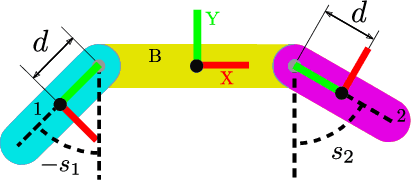Henk Nijmeijer
Model Validation of a Low-Speed and Reverse Driving Articulated Vehicle
Oct 01, 2023Abstract:For the autonomous operation of articulated vehicles at distribution centers, accurate positioning of the vehicle is of the utmost importance. Automation of these vehicle poses several challenges, e.g. large swept path, asymmetric steering response, large slide slip angles of non-steered trailer axles and trailer instability while reversing. Therefore, a validated vehicle model is required that accurately and efficiently predicts the states of the vehicle. Unlike forward driving, open-loop validation methods can not be used for reverse driving of articulated vehicles due to their unstable dynamics. This paper proposes an approach to stabilize the unstable pole of the system and compares three vehicle models (kinematic, non-linear single track and multibody dynamics model) against real-world test data obtained from low-speed experiments at a distribution center. It is concluded that single track non-linear model has a better performance in comparison to other models for large articulation angles and reverse driving maneuvers.
On Centroidal Dynamics and Integrability of Average Angular Velocity
Jan 10, 2017

Abstract:In the literature on robotics and multibody dynamics, the concept of average angular velocity has received considerable attention in recent years. We address the question of whether the average angular velocity defines an orientation framethat depends only on the current robot configuration and provide a simple algebraic condition to check whether this holds. In the language of geometric mechanics, this condition corresponds to requiring the flatness of the mechanical connection associated to the robotic system. Here, however, we provide both a reinterpretation and a proof of this result accessible to readers with a background in rigid body kinematics and multibody dynamics but not necessarily acquainted with differential geometry, still providing precise links to the geometric mechanics literature. This should help spreading the algebraic condition beyond the scope of geometric mechanics,contributing to a proper utilization and understanding of the concept of average angular velocity.
 Add to Chrome
Add to Chrome Add to Firefox
Add to Firefox Add to Edge
Add to Edge